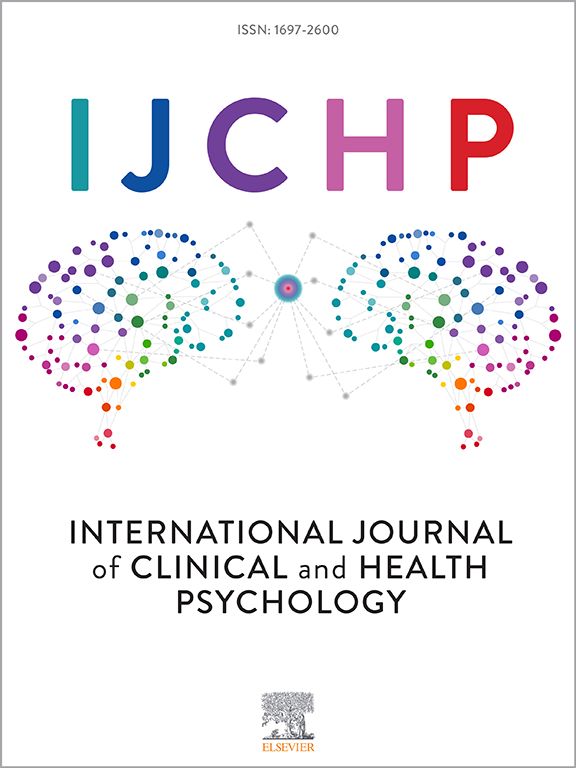An electroencephalography connectome predictive model of craving for methamphetamine
IF 4.4
1区 心理学
Q1 PSYCHOLOGY, CLINICAL
International Journal of Clinical and Health Psychology
Pub Date : 2025-01-01
DOI:10.1016/j.ijchp.2025.100551
引用次数: 0
Abstract
Background
Methamphetamine use disorder (MUD) is characterized by prominent psychological craving and its relapsing nature. Previous studies have linked trait impulsivity and abstinence duration to drug use, but the neural substrates of drug cue-induced craving and its relationship with these traits remain unclear in MUD.
Methods
We acquired high-density resting-state electroencephalography (EEG) after participants watched a five-minute video demonstrating methamphetamine use. Combining precise source imaging to reconstruct brain activities with connectome predictive modeling (CPM), we built a craving-specific network within beta band activity from two independent MUD cohorts (N=144 for model development and N=47 for validation).
Results
This network reveals a unified neural signature for craving in MUD, spanning multiple brain networks including the medial prefrontal, frontal parietal, and subcortical networks. Our findings underscored the mediating role of this craving connectome profile in modulating the relationship between abstinence duration and craving intensity. Moreover, trait impulsivity mediated the relationship between the EEG-derived craving connectome and cue-induced craving.
Conclusion
This study presents a novel predictive model that utilizes sourced connectivity from high-density EEG of resting-state recording to successfully predict methamphetamine craving in abstinent individuals with MUD. These results shed light on the cognitive organization involved in craving, involving cognitive control, attention, and reward reactivity. A comprehensive analysis reveals EEG data's capacity to decipher craving's complex dynamics, facilitating improved understanding and targeted treatments for substance use disorders.
对甲基苯丙胺渴望的脑电图连接组预测模型
甲基苯丙胺使用障碍(methamphetamine use disorder, MUD)具有明显的心理渴求和反复发作的特点。先前的研究已经将冲动和戒断持续时间与药物使用联系起来,但在MUD中,药物线索诱导的渴望的神经基础及其与这些特征的关系尚不清楚。方法在受试者观看了一段5分钟的甲基苯丙胺使用视频后,进行高密度静息状态脑电图(EEG)检查。结合精确源成像和连接组预测建模(CPM)重建大脑活动,我们从两个独立的MUD队列(模型开发N=144,验证N=47)中建立了β带活动的渴望特异性网络。结果该网络揭示了MUD中渴望的统一神经特征,跨越多个脑网络,包括内侧前额叶、额顶叶和皮层下网络。我们的研究结果强调了这种渴望连接体在调节禁欲持续时间和渴望强度之间的关系中的中介作用。此外,特质冲动性在脑电衍生的渴望连接体和线索诱导的渴望之间起到中介作用。结论本研究提出了一种新的预测模型,该模型利用静息状态记录的高密度脑电图源连接成功预测了戒断MUD个体的甲基苯丙胺渴望。这些结果揭示了与渴望有关的认知组织,包括认知控制、注意力和奖励反应。一项全面的分析揭示了脑电图数据破译渴望的复杂动态的能力,促进了对物质使用障碍的理解和有针对性的治疗。
本文章由计算机程序翻译,如有差异,请以英文原文为准。
求助全文
约1分钟内获得全文
求助全文
来源期刊

International Journal of Clinical and Health Psychology
PSYCHOLOGY, CLINICAL-
CiteScore
10.70
自引率
5.70%
发文量
38
审稿时长
33 days
期刊介绍:
The International Journal of Clinical and Health Psychology is dedicated to publishing manuscripts with a strong emphasis on both basic and applied research, encompassing experimental, clinical, and theoretical contributions that advance the fields of Clinical and Health Psychology. With a focus on four core domains—clinical psychology and psychotherapy, psychopathology, health psychology, and clinical neurosciences—the IJCHP seeks to provide a comprehensive platform for scholarly discourse and innovation. The journal accepts Original Articles (empirical studies) and Review Articles. Manuscripts submitted to IJCHP should be original and not previously published or under consideration elsewhere. All signing authors must unanimously agree on the submitted version of the manuscript. By submitting their work, authors agree to transfer their copyrights to the Journal for the duration of the editorial process.
 求助内容:
求助内容: 应助结果提醒方式:
应助结果提醒方式:


